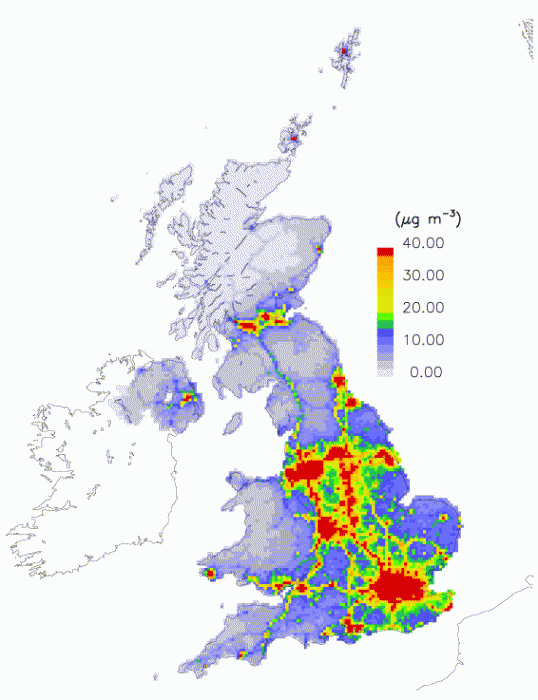
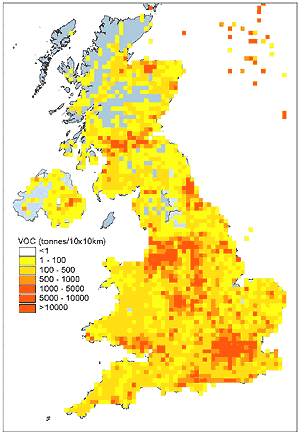
Cancer Epidemiology; combined effect of powerful radio and TV broadcast transmitters and atmospheric pollution in the UK, by Dr Chris Barnes, Bangor Scientific and Educational Consultants email doctor.barnes@univ.bangor.ac.uk
Dr Barnes Homepage http://www.drchrisbarnes.co.uk
Abstract
Historic studies which show associations between the use of electromagnetic transmission technology namely TV and FM radio and cancer are re-visited. There is up to 40% less cancer in the Ohio Amish who do not use electromagnetic technologies. The studies of Dolk (1997) in particular produce inconclusive results. This study shows it is possible to reconcile such apparent differences if a) RF RADIATION is regarded rather as a cancer promoter than an initiator and b) if levels of atmospheric pollution at and around each transmitter site are taken into account. There is some support for the notion that TV emissions are more potent than mixed emissions or FM only emissions and this is line with the earlier work and suggestion of Morton and Phillips 1983.
Introduction
Over the past two decades or so and coinciding with the massive increase in mobile telephone use there has been continued interest in radio frequency safety (1).
One way to look at the effect of radio frequency (RF) safety is to consider cancer epidemiology in geographical areas around established powerful sources of RF radiation such as Radio and Television transmitters.
Several studies have been made worldwide and all have reached somewhat different conclusions. This has left critics of the notion that RF may be either at the most a carcinogen or at the least a cancer promoter to suggest that there is no relevant association whatsoever between RF and cancer and thus that RF is completely safe unless, that it is, it is present at such power densities as to cause body heating.
Of the most significant known studies are those of Cherry (2002) (2), Morton and Phillips (1983) (3) and the two studies of Dolk (4,5). Dolk (I) (1997)(4) was an epidemiological study based on the Sutton Coldfield high power FM and TV transmitter and Dolk (II) was based on several different kinds of high power transmitter spread throughout the UK (5).
The Cherry study of the Sutro TV tower in San Francisco (2) showed RF to apparently be a carcinogen based on excess cancer cases at places in relation to antenna filed strength and local topography. It is believed to be the only epidemiology study to reach this conclusion although the WHO recently branded mobile phone radiation as a potential carcinogen with respect to gliomas (6).
The study of Morton and Phillips (3) concluded for the Portland Vancouver Metropolitan area that TV emissions were a more dangerous cancer promoter at least for leukaemia and breast cancer than FM emissions despite the FM power densities being significantly greater.
Dolk(I) for Sutton Coldfield concluded there was an almost doubled relative cancer risk based on O/E ratio within a few kilometres of the transmitter (4). However, Dolk (II) could not duplicate the Sutton Coldfield results or even produce anything remotely similar for high power transmitters in general around the UK (5) . This being somewhat surprising given that most of these other sites had similar transmitter powers, frequencies and antenna radiation patterns.
Hypothesis
A perfectly plausible hypothesis to account for the observed discrepancies of Dolk I and Dolk II is that if RF is acting merely as a cancer promoter then there might be different levels of actual carcinogen or cancer initiator present at and around the these different UK transmitter sites.
The present author has observed and association between the effects of atmospheric pollution and RF on other biological systems, namely trees and shrubs and between the action of ELF and pollution (7). Furthermore he has also recently proposed a new hypothesis to account for the early peak in childhood cancers in terms of roadside pollution and RF radiation. Further support for this notion comes from considering cancer epidemiology in the Amish, which when adjusted for occupation shows at least a 40% reduction in all types of cancers, see Carter PhD Thesis 2008 (8). The Amish do not use electricity, RF or motor vehicles. The latter being a strong source of initiator pollutants. Sutton Coldfield is adjacent to some of the most heavily polluted motorways in Britain.
Experimental
The experimental data sets of Dolk (4,5) are re-used here. Data on specific cancer causing pollutants such as PAH and PM2.5 from diesel vehicles or benzene from petrol vehicles is not universally available for the British Isles but NO2 (nitrogen dioxide) levels are closely indicative of the rest. NO2 data is available from the DEFRA website. Most NO2 in the UK comes from motor vehicles and its atmospheric concentration closely mirrors for example VOCS which include certain carcinogens. Nano-metal pollution, especially nickel, has also been linked with roads and associated with cancer. One would perhaps also these expect levels to fairly closely NO2 and VOC.


NO2 VOC
The data O/E ratios of Dolk have been plotted against average NO2 air densities for the various locations and types of transmitter provided by the Dolk (I) and (II) studies. NO2 densities were used as more accurate data sets are available for the whole UK but as can be seen they mirror VOCS closely.
Results and Discussion
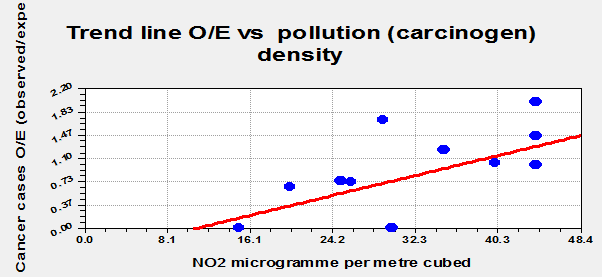
Figure 1
Figure 1 above shows a plot of O/E versus NO2 density for all types of transmitter. The general trend is for O/E to increase with pollution density. Since each transmitter site at each different location in the UK is associated with unique levels of atmospheric pollution, this trend alone is sufficient to explain why the results of Dolk (II) did not match those of Dolk (I).
The data form a clear trend line but some points appear to lie with O/E values higher than the line and some below. Closer inspection shows that some of the Dolk (II) results for Groups 1 and 2 which include high power TV transmitters are responsible for the points with an O/E ratio greater than average according to prediction by the trend line. Further close inspection suggests that Dolk (II) Group 3 (FM only transmitters) produce results which fall well below average O/E ratio when compared with the average trend line especially at low and moderate pollution levels.
The classic form of any disease/dose response follows a sigmoid model (9). If we assume the pollution volume to be providing the carcinogen (dose), then the O/E ratio to be the response and RF to be a cancer promoter then we would expect the RF to alter the parameters of the sigmoidal growth curve according to its effectiveness as a promoter.
Figures 2 and 3 show the data for TV transmitters and FM only transmitters separated into separately fitted curves according to a Morgan-Mercer-Florin (MMF) sigmoidal growth model, of the general form y= a*b+c*x^d)/(b+x^d ).
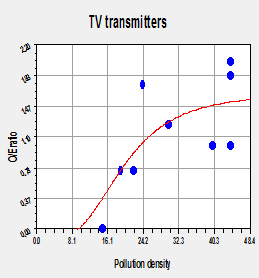
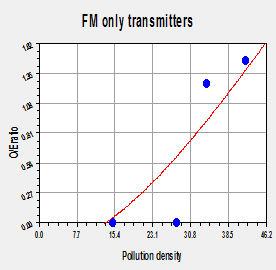
Figure 2 Figure 3
As can be seen above, the O/E ratio for TV transmitters when plotted against pollution volume is considerably greater than for FM transmitters for all except the highest levels of pollution. This result is in strong support of the finding of Morton and Phillips which also concluded that TV transmitters are far more potent cancer promoters than FM transmitters.
|
|
a |
b |
c |
d |
|
FM |
-.23 |
5.18*10^3 |
10 |
1.83 |
|
|
|
|
|
|
|
TV |
-.15 |
1.62*10^4 |
.16 |
.32 |
|
|
|
|
|
|
|
ALL |
-.13 |
6.76*10^3 |
12.16 |
.18 |
The MMF parameters for the best fits are shown in the table above. The parameter b appears sensitive to the type of transmitter. The value of ‘b’ for TV transmitters is more than three times greater than ‘b’ for FM transmitters and the model appears reasonably validated in that ‘b’ for all transmitters lies somewhere in between.
Conclusion
The data sets of Dolk (1997) (4,5) have been re-evaluated by considering atmospheric pollution levels in the region of each transmitter site. The assumption made being that NO2 levels mirror those of well known airborne carcinogens.
There is a clear trend line between O/E ratio and pollution level. Since Sutton Coldfield lies in a highly polluted location compared with some of the sites in the Dolk (II) study, such differences in pollution density are more than sufficient to explain the lack of agreement between the Dolk (I) and (II) studies. Furthermore the results show that for all except at the very highest levels of pollution the O/E ratios are significantly greater for TV transmitters and/or sites where there are mixed transmitters included TV transmitters than for sites where there are FM transmitters alone. This is in line with the conclusion of Morton and Phillips (3).
Further work
Morton and Phillips (3) have speculated that synchronisation pulses make TV transmissions more potent as Cancer Promoters. The author hopes to produce a hypothetical paper on this and similar issues in the near future.
References
http://environment.about.com/od/mobilephones/a/phone_safety.htm
http://www.neilcherry.com/documents/90_r3_EMR_Sutro_Paper_09-02.pdf
Morton, W. & Phillips, D. (1983). Radioemission Density and Cancer Epidemiology in the Portland Metropolitan Area, Research Triangle Park, NC: U.S. Environmental Protection Agency, June 1983.
Dolk I (1997)http://www.ncbi.nlm.nih.gov/pubmed/8982016
Dolk II (1997)http://www.ncbi.nlm.nih.gov/pubmed/8982017
;http://www.drfranklipman.com/cell-phones-possible-carcinogen/
http://dwb4.unl.edu/Chem/CHEM869Z/CHEM869ZLinks/www.curvefit.com/introduction89.htm